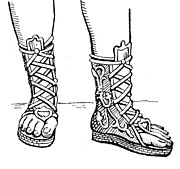
An artist is a person engaged in an activity related to creating art, practicing the arts, or demonstrating an art. The common usage in both everyday speech and academic discourse refers to a practitioner in the visual arts only. However, the term is also often used in the entertainment business, especially in a business context, for musicians and other performers. "Artiste" is a variant used in English in this context, but this use has become rare. The use of the term "artist" to describe writers is valid, but less common, and mostly restricted to contexts such as critics' reviews.

In Greek mythology and ancient Greek religion, Mnemosyne is the goddess of memory and the mother of the nine Muses by her nephew Zeus. In the Greek tradition, Mnemosyne is one of the Titans, the twelve divine children of the earth-goddess Gaia and the sky-god Uranus. The term Mnemosyne is derived from the same source as the word mnemonic, that being the Greek word mnēmē, which means "remembrance, memory".

Euterpe was one of the Muses in Greek mythology, presiding over music. In late Classical times, she was named muse of lyric poetry. She has been called "Giver of delight" by ancient poets.
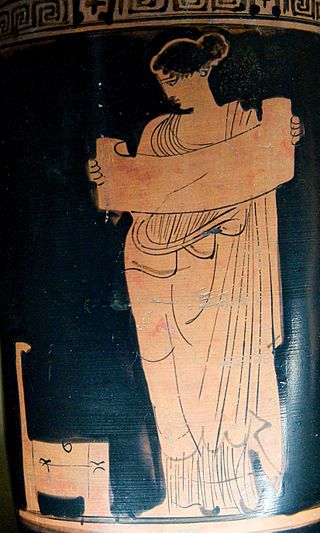
In ancient Greek religion and mythology, the Muses are the inspirational goddesses of literature, science, and the arts. They were considered the source of the knowledge embodied in the poetry, lyric songs, and myths that were related orally for centuries in ancient Greek culture.

In Greek mythology, Erato is one of the Greek Muses, the inspirational goddesses of literature, science, and the arts. The name would mean "desired" or "lovely", if derived from the same root as Eros, as Apollonius of Rhodes playfully suggested in the invocation to Erato that begins Book III of his Argonautica.

Melpomene is the Muse of tragedy in Greek mythology. She is described as the daughter of Zeus and Mnemosyne along with the other Muses, and she is often portrayed with a tragic theatrical mask.

In Greek mythology, Thalia, also spelled Thaleia, was one of the Muses, the goddess who presided over comedy and idyllic poetry. In this context her name means "flourishing", because the praises in her songs flourish through time.
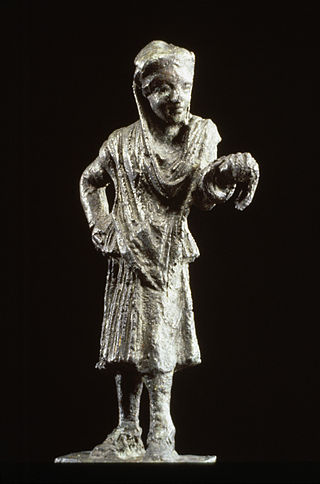
A theatrical culture flourished in ancient Greece from 700 BC. At its centre was the city-state of Athens, which became a significant cultural, political, and religious place during this period, and the theatre was institutionalised there as part of a festival called the Dionysia, which honoured the god Dionysus. Tragedy, comedy, and the satyr play were the three dramatic genres emerged there. Athens exported the festival to its numerous colonies. Modern Western theatre comes, in large measure, from the theatre of ancient Greece, from which it borrows technical terminology, classification into genres, and many of its themes, stock characters, and plot elements.
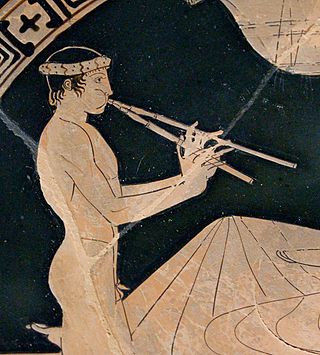
An aulos or tibia (Latin) was a wind instrument in ancient Greece, often depicted in art and also attested by archaeology.

The satyr play is a form of Attic theatre performance related to both comedy and tragedy. It preserves theatrical elements of dialogue, actors speaking verse, a chorus that dances and sings, masks and costumes. Its relationship to tragedy is strong; satyr plays were written by tragedians, and satyr plays were performed in the Dionysian festival following the performance of a group of three tragedies. The satyr play's mythological-heroic stories and the style of language are similar to that of the tragedies. Its connection with comedy is also significant – it has similar plots, titles, themes, characters, and happy endings. The remarkable feature of the satyr play is the chorus of satyrs, with their costumes that focus on the phallus, and with their language, which uses wordplay, sexual innuendos, references to breasts, farting, erections, and other references that do not occur in tragedy. As Mark Griffith points out, the satyr play was "not merely a deeply traditional Dionysiac ritual, but also generally accepted as the most appropriate and satisfying conclusion to the city’s most complex and prestigious cultural event of the year."
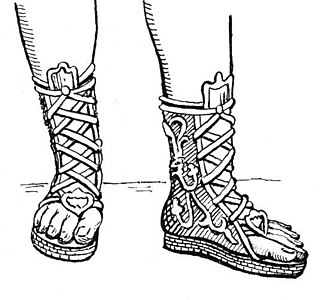
A buskin is a knee- or calf-length boot made of leather or cloth, enclosed by material, and laced, from above the toes to the top of the boot, and open across the toes.

A himation was a type of clothing, a mantle or wrap worn by ancient Greek men and women from the Archaic period through the Hellenistic period. It was usually worn over a chiton and/or peplos, but was made of heavier drape and played the role of a cloak or shawl. When the himation was used alone, without a chiton, it served both as a chiton and as a cloak. The himation was markedly less voluminous than the Roman toga. Many vase paintings depict women wearing a himation as a veil covering their faces.

The Disquieting Muses is a painting by the Italian metaphysical painter Giorgio de Chirico.

The architectural form of theatre in Rome has been linked to later, more well-known examples from the 1st century BC to the 3rd Century AD. The theatre of ancient Rome referred to a period of time in which theatrical practice and performance took place in Rome. The tradition has been linked back even further to the 4th century BC, following the state’s transition from monarchy to republic. Theatre during this era is generally separated into genres of tragedy and comedy, which are represented by a particular style of architecture and stage play, and conveyed to an audience purely as a form of entertainment and control. When it came to the audience, Romans favored entertainment and performance over tragedy and drama, displaying a more modern form of theatre that is still used in contemporary times.

Representations or analogues of one or more of the nine Muses of Greek mythology have appeared in many different modern fictional works.
The Studiolo of the Palazzo Belfiore was a former study, or room for intellectual pursuits, that was once found in a razed Renaissance palace in Ferrara, region of Emilia-Romagna, Italy. While the palace has disappeared, records do list the paintings, consisting of depictions of muses, that hung in the room. These secular works are now dispersed across museums, but their collective presences recall the renewed attention of Renaissance patrons to symbols from classic mythology.

The comedy and tragedy masks are a pair of masks, one crying and one laughing, that have widely come to represent the performing arts. Originating in the theatre of ancient Greece, the masks were said to help audience members far from the stage to understand what emotions the characters were feeling.
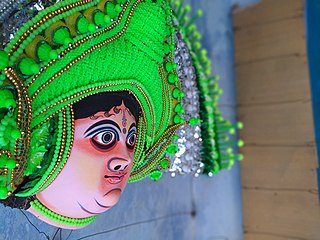
The Chhau mask is a traditional cultural heritage of Purulia in the Indian state of West Bengal. The Chhau mask of Purulia is registered on the List of Geographical Indications. As the basic difference of Purulia Chhau the mask is unique and traditional.

David Garrick Between Tragedy and Comedy is a 1761 painting by the English painter Joshua Reynolds, depicting the actor and playwright David Garrick caught between the Muses of Tragedy and Comedy. It is regarded as one of Reynolds's most studied and well-known paintings, and is now in the collection of Waddesdon Manor, Buckinghamshire.
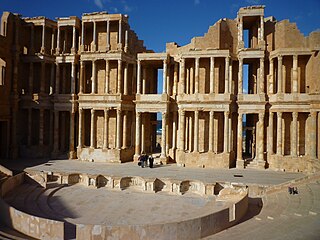
The ancient theater of Sabratha is the Roman theater of the ancient city of Sabratha in Proconsular Africa, on the Mediterranean coast of northwestern Libya. The date and circumstances of its construction are undetermined, as are those of its abandonment. Archaeologists can only advance approximate hypotheses, and place its construction around the end of the first century or the beginning of the second. After centuries of abandonment, excavators rediscovered the city and its monument during the Italian occupation of Libya in the early 20th century. The excavation and restoration work carried out between 1927 and 1937 made the theater the most important monument on the Sabratha site, the largest theater in Roman Africa, and the most spectacular in the Roman world in two respects: the colonnade of its stage wall was almost completely reconstructed by a three-level anastylosis, and an exceptional series of bas-reliefs adorned the base of the stage. It could accommodate around 5,000 spectators and, in its restored state, still holds 1,500.

